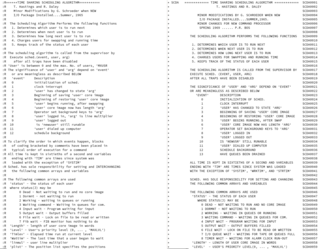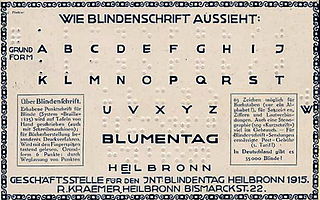Related Research Articles

Braille is a tactile writing system used by people who are visually impaired. It can be read either on embossed paper or by using refreshable braille displays that connect to computers and smartphone devices. Braille can be written using a slate and stylus, a braille writer, an electronic braille notetaker or with the use of a computer connected to a braille embosser.

A braille embosser is an impact printer that renders text as tactile braille cells. Using braille translation software, a document or digital text can be embossed with relative ease. This makes braille production efficient and cost-effective. Braille translation software may be free and open-sourced or paid. Braille embossers can emboss single-sided or double-sided and can produce 6- or 8-dot braille.

A refreshable braille display or braille terminal is an electro-mechanical device for displaying braille characters, usually by means of round-tipped pins raised through holes in a flat surface. Visually impaired computer users who cannot use a standard computer monitor can use it to read text output. Deafblind computer users may also use refreshable braille displays.

The Compatible Time-Sharing System (CTSS) was the first general purpose time-sharing operating system. Compatible Time Sharing referred to time sharing which was compatible with batch processing; it could offer both time sharing and batch processing concurrently.

New York Point is a braille-like system of tactile writing for the blind invented by William Bell Wait (1839–1916), a teacher in the New York Institute for the Education of the Blind. The system used one to four pairs of points set side by side, each containing one or two dots. The most common letters are written with the fewest points, a strategy also employed by the competing American Braille.

The Perkins Brailler is a "braille typewriter" with a key corresponding to each of the six dots of the braille code, a space key, a backspace key, and a line space key. Like a manual typewriter, it has two side knobs to advance paper through the machine and a carriage return lever above the keys. The rollers that hold and advance the paper have grooves designed to avoid crushing the raised dots the brailler creates.
Tactile graphics, including tactile pictures, tactile diagrams, tactile maps, and tactile graphs, are images that use raised surfaces so that a visually impaired person can feel them. They are used to convey non-textual information such as maps, paintings, graphs and diagrams.
Braille ASCII is a subset of the ASCII character set which uses 64 of the printable ASCII characters to represent all possible dot combinations in six-dot braille. It was developed around 1969 and, despite originally being known as North American Braille ASCII, it is now used internationally.
Braille technology is assistive technology which allows blind or visually impaired people to read, write, or manipulate braille electronically. This technology allows users to do common tasks such as writing, browsing the Internet, typing in Braille and printing in text, engaging in chat, downloading files and music, using electronic mail, burning music, and reading documents. It also allows blind or visually impaired students to complete all assignments in school as the rest of their sighted classmates and allows them to take courses online. It enables professionals to do their jobs and teachers to lecture using hardware and software applications. The advances in Braille technology are meaningful because blind people can access more texts, books, and libraries, and it also facilitates the printing of Braille texts.
The Braille Challenge is an annual two-stage Braille literacy competition designed to motivate blind students to emphasize their study of Braille. The program parallels with the importance and educational purpose of a spelling bee for sighted children. Braille is a reading and writing method that breaks language into a code of raised dots. There are three grades of braille:

The Mountbatten Brailler is an electronic machine used to type braille on braille paper. It uses the traditional "braille typewriter keyboard" of the Perkins Brailler with modern technology, giving it a number of additional features such as word processing, audio feedback and embossing. The machine was pioneered and developed at the United Kingdom's Royal National College for the Blind in Hereford by Ernest Bate.

English Braille, also known as Grade 2 Braille, is the braille alphabet used for English. It consists of around 250 letters (phonograms), numerals, punctuation, formatting marks, contractions, and abbreviations (logograms). Some English Braille letters, such as ⠡⟨ch⟩, correspond to more than one letter in print.
A BrailleNote is a computer made by HumanWare for persons with visual impairments. It has either a braille keyboard or a Qwerty Keyboard, a speech synthesizer, and a 32- or 18-column refreshable Braille display, depending on model. The "VoiceNote" is the same device without a braille display. The BrailleNote GPS is an 18 or 32 cell BrailleNote with an External GPS module, BrailleNote GPS.

Caryn Linda Navy is an American mathematician and computer scientist. Blind since childhood, she is chiefly known for her work in set-theoretic topology and Braille technology.

Russian Braille is the braille alphabet of the Russian language. With suitable extensions, it is used for languages of neighboring countries that are written in Cyrillic in print, such as Ukrainian and Mongolian. It is based on the Latin transliteration of Cyrillic, with additional letters assigned idiosyncratically. In Russian, it is known as the Braille Script.

French Braille is the original braille alphabet, and the basis of all others. The alphabetic order of French has become the basis of the international braille convention, used by most braille alphabets around the world. However, only the 25 basic letters of the French alphabet plus w have become internationalized; the additional letters are largely restricted to French Braille and the alphabets of some neighboring European countries.

German Braille is one of the older braille alphabets. The French-based order of the letter assignments was largely settled on with the 1878 convention that decided the standard for international braille. However, the assignments for German letters beyond the 26 of the basic Latin alphabet are mostly unrelated to French values.

A braille e-book is a refreshable braille display using electroactive polymers or heated wax rather than mechanical pins to raise braille dots on a display. Though not inherently expensive, due to the small scale of production they have not been shown to be economical.
Scandinavian Braille is a braille alphabet used, with differences in orthography and punctuation, for the languages of the mainland Nordic countries: Danish, Norwegian, Swedish, and Finnish. In a generally reduced form it is used for Greenlandic.

David Holladay was an American computer programmer who worked on early Braille translator word processing software allowing blind Apple Computer users to enter, edit, and translate text.
References
- ↑ Braillestandaard voor algemeen gebruik in het Nederlandse taalgebied published by the Dutch braille authority, retrieved 2/24/2023
- ↑ Support for wireless braille displays in iOS 5, Apple Accessibility retrieved 3/29/2012
- ↑ Robobraille (server-based braille software) retrieved 3/29/2012
- ↑ Braille Translation System for the IBM 704 by Ann S. Schack and R.T. Mertz, 1961 retrieved 3/30/2016
- ↑ Computer Translation: Grade 2 from Print; Report of American Printing House of the Blind, by Ann Schack, et al., June 1969 retrieved 3/30/2016
- ↑ Robert W. Mann, Sc.D., Selected Perspectives on a Quarter Century of Rehabilitation Engineering, Journal of Rehabilitation Research, and Development Vol. 23 No. 4, Pages 1-6 retrieved 3/30/2016
- ↑ History of Duxbury Systems, retrieved 3/29/2012
- ↑ Computerised Braille Production Proceedings of the First International Workshop in Münster Germany, 1973 edited by R. A. J. Gildea, G. Hubner, H. Werner, 1974 retrieved 3/30/2016
- ↑ Documents on Automated Braille Production: An Historical Resource retrieved 3/30/2016